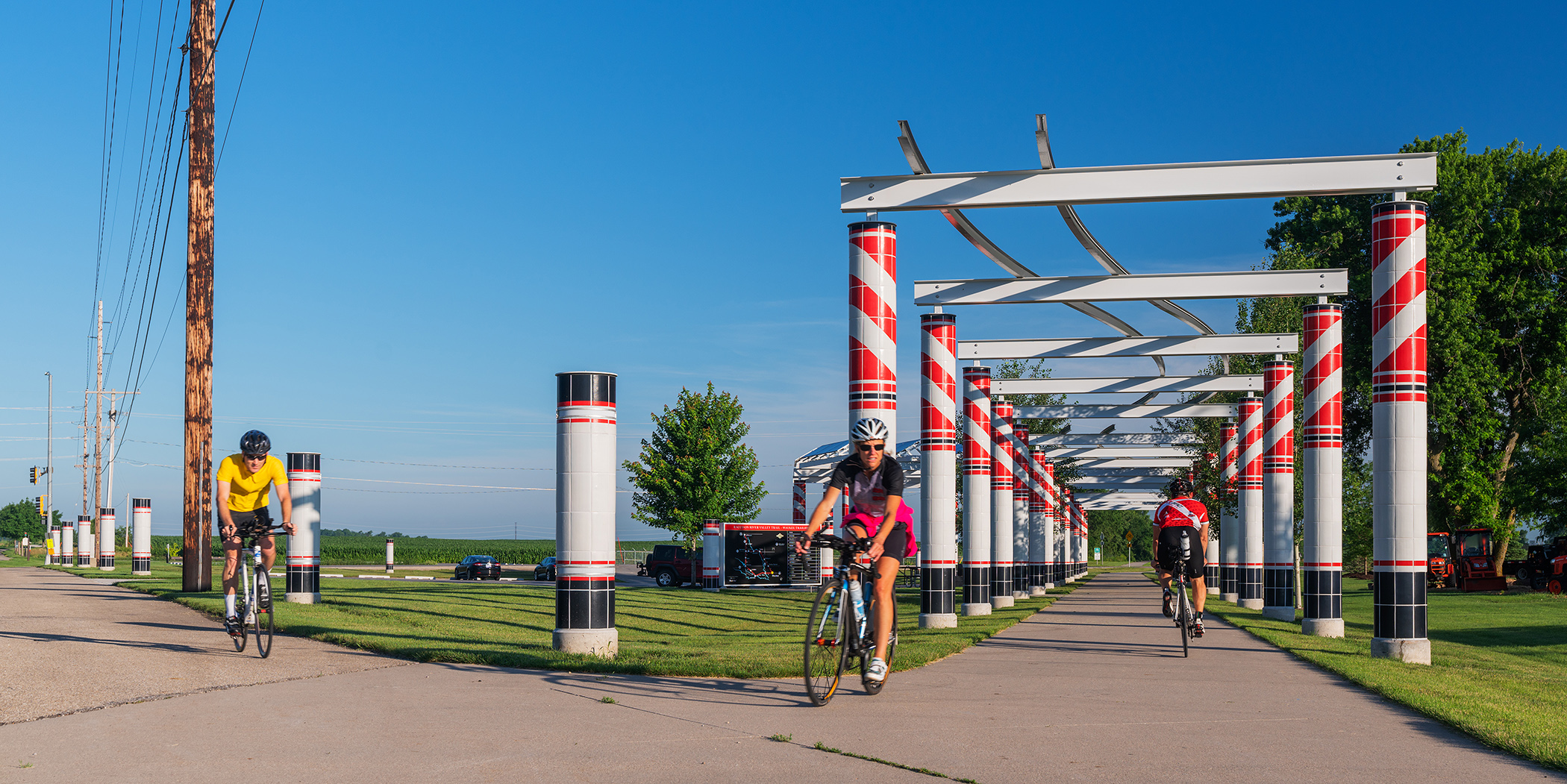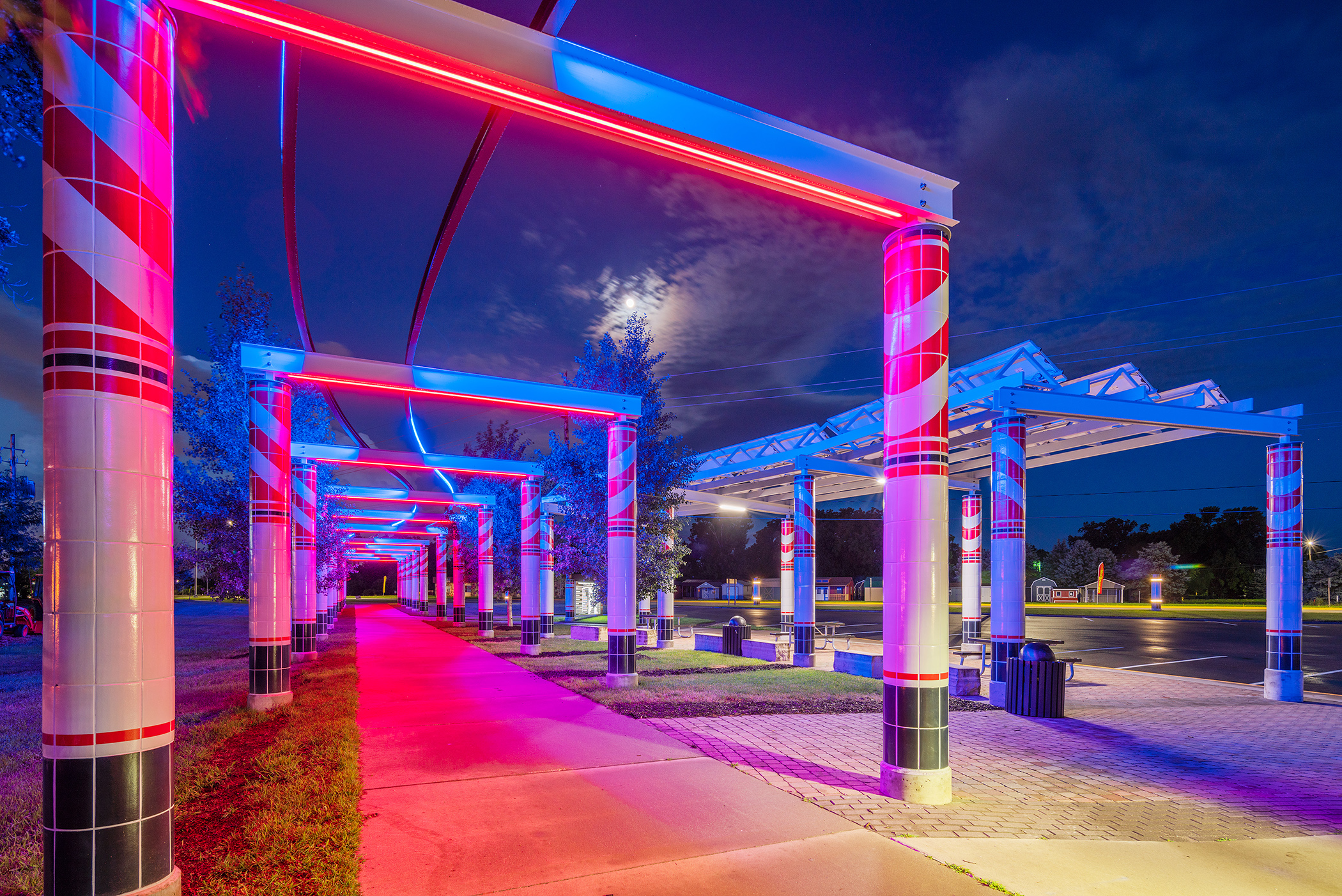





Client: City of Waukee, Iowa
Location: Waukee, IA, United States
Completion date: 2018
Artwork budget: $952,850
Project Team
Artist
David Dahlquist
RDG Dahlquist Art Studio
Client
Jim Miller
Raccoon River Valley Trail Association
Landscape Architect
Scott Crawford
RDG Planning & Design
Landscape Architect
Eric Iverson
RDG Planning & Design
Project Manager
Don Scandrett
RDG Planning & Design
Lighting Design
Renee Thomas
RDG Planning & Design
Project Management
RDG Planning & Design
Artist
Kate Chandler
RDG Dahlquist Art Studio
Graphic Design
RDG Dahlquist Art Studio
Structural Engineering
Saul Engineering
Electrical
Biermann Electric
Concrete
C. Green Contractor, Inc.
Plastic
Regal Plastic
Tile Installation
Des Moines Marble & Mantel
Caulking & Sealing
Midwest Caulking, Inc.
Overview
“Waukee Railroad Pergola: In the Shadows of the Rails” is a dynamic integration of public-art and infrastructure based on the history of the railroad. Located at the trailhead of the Raccoon River Valley Trail, the installation creates a unique experience for visitors and a new destination for bicyclists and pedestrians alike. The sculptural installation has become an iconic regional landmark, a colorful and whimsical connection between the past, present, and future of the community. A trellis of railroad rails casts shadows that weave along the trail. A series of handmade ceramic clad columns, over 350 feet long, frame the trail.
Goals
The primary goal for the integration of the public artwork centered on the design and creation of a major trailhead that would welcome the public to the City of Waukee and become a gathering area for the Raccoon River Valley Trail, the longest paved loop in the country. Another significant objective: “make it fun,” an active location to draw a new and larger audience to the trail communities. The project began with extensive artist facilitation and public input to inform the process and give direction to the conceptual development. The installation functions in many different ways, with benefits related to health and recreation, as well as a catalyst for regional economic development, reaching out to other communities connected by the trail. Accompanying ornamental bollards wrap the trailhead to reinforce the “triangle,” symbolic of the original town center. LED illumination gives dimension to the structure and provides a colorful “light show,” thoughtful of the site as it changes from day to night. The pergola installation introduces a meaningful contemporary visual theme to achieve character and continuity. It has been scaled in other locations to welcome riders to the entrances of other communities along the trail.
Process
Public art is about process. Through a combination of site-specific research, documentation, careful listening, and artistic insight, a meaningful story emerged. The Waukee Railroad Pergola project represents a collaboration between many different people and organizations: artists, community leaders and activists, trail association members, state cultural and Department of Transportation officials, engineers, architects, landscape architects, lighting designers, educators, students, contractors and fabricators, the public in general, and many donors organized through public/private partnerships, working passionately to bring the project to life. The process began with “artistic fact-finding,” a series of cultural engagement meetings that gathered the interest, ideas, and involvement of the community. Options for distinct visual expressions were developed and vetted, building consensus along the way. The result is a memorable destination and experience that welcomes visitors from across the country.
Additional Information
The Raccoon River Valley Trail Association, in conjunction with the City of Waukee, were committed to the “story,” the integration of the public artwork and the implementation of the project in profound ways. Over a three year period, the project became a reality in large part, due to the relationships between artists and community, and the grass-roots marketing and fundraising efforts of key individuals.